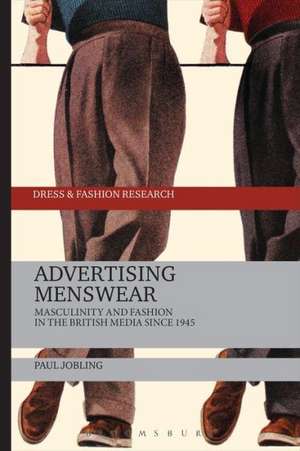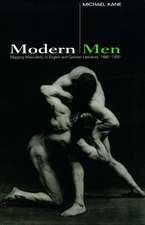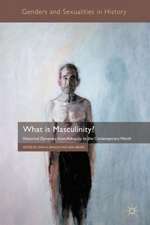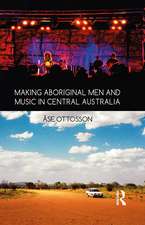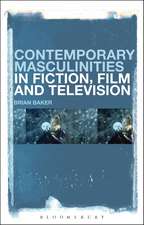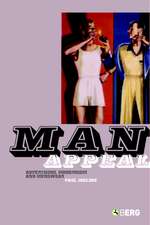Advertising Menswear: Masculinity and Fashion in the British Media since 1945: Dress and Fashion Research
Autor Paul Joblingen Limba Engleză Hardback – 12 mar 2014
| Toate formatele și edițiile | Preț | Express |
|---|---|---|
| Paperback (1) | 182.65 lei 6-8 săpt. | |
| Bloomsbury Publishing – 29 iul 2015 | 182.65 lei 6-8 săpt. | |
| Hardback (1) | 775.02 lei 6-8 săpt. | |
| Bloomsbury Publishing – 12 mar 2014 | 775.02 lei 6-8 săpt. |
Preț: 775.02 lei
Preț vechi: 1113.65 lei
-30% Nou
Puncte Express: 1163
Preț estimativ în valută:
148.33€ • 160.12$ • 124.38£
148.33€ • 160.12$ • 124.38£
Carte tipărită la comandă
Livrare economică 19 aprilie-03 mai
Preluare comenzi: 021 569.72.76
Specificații
ISBN-13: 9781472533432
ISBN-10: 1472533437
Pagini: 272
Ilustrații: 50 bw illus
Dimensiuni: 156 x 234 x 20 mm
Greutate: 0.59 kg
Editura: Bloomsbury Publishing
Colecția Bloomsbury Academic
Seria Dress and Fashion Research
Locul publicării:London, United Kingdom
ISBN-10: 1472533437
Pagini: 272
Ilustrații: 50 bw illus
Dimensiuni: 156 x 234 x 20 mm
Greutate: 0.59 kg
Editura: Bloomsbury Publishing
Colecția Bloomsbury Academic
Seria Dress and Fashion Research
Locul publicării:London, United Kingdom
Caracteristici
Scholarly yet accessibly written with students in mind
Notă biografică
Paul Jobling is Researcher in Arts and Architecture, University of Brighton, UK. He is the author of Man Appeal (Berg, 2005).
Cuprins
INTRODUCTIONPART ONEGoing for a Burton: menswear advertising from austerity to affluence, 1945-1957Introduction1.0: The post-war market for men's clothing2.0: Menswear advertising: agents, accounts and audiences: 'Will it be seen? Will it be remembered?' Will it be "accepted"?'3.0: The economics of press advertising 4.0: The design and rhetoric of menswear press advertisements5.0: The art versus commerce debate6.0: Poster publicity and menswear7.0: Early commercial television and menswear, 1955-19608.0: The impact of consumer psychology and motivation research9.0: 'Feeling with' and 'feeling into': appealing to men and women10.0: The turn to new consumers and youth culturePART TWOThinking young: menswear advertising and the generation games, 1958-1978Introduction1.0: Sedimenting the youth market2.0: Cinema and television advertising3.0: Menswear advertising in newspapers and magazines4.0: Poster publicity and menswear5.0: 'You bring the body, we've got the clothes': publicity for tailors6.0: From dummies to dandies7.0: Ironing out the creases: artificial fibres and menswear advertising8.0: Synthesising sex: the utopian and ludic valorization of artificial and natural fibres9.0: 'Cloth for Men': wool and he whisper of darker things10.0: Looking good, feeling good11.0: The changing of the guardPART THREELeader of the pack: jeans advertising since the 1960sIntroduction1.0: The Jeans market and advertising between 1950-19852.0: Levi's 501: back to the future3.0: Here comes the new man - again4.0: A soundtrack for consumerism: music, image and myth5.0: More than just a number6.0: Racial sameness and racial difference7.0: From 'Mothers' to 'Flat Eric'EPILOGUEGetting the Right Fit - Objects/Images/ReadersBibliographyIndex
Recenzii
Fascinating as a study of changing attitudes and technologies over the second half of the 20th century ... The attempts of menswear advertisers to anticipate, respond to, and initiate changes from a postwar setting of mainly static images and relatively static mores to the unimaginably transformed, contemporary technologies and standards is chronicled in a straightforward and entertaining way ... The book deserves a broad audience.
Rooted in archival research and through rich illustrations and extensive appendices, Jobling has given us yet another piece of quality scholarship. This text will appeal to researchers interested in the representation of clothing and fashion, masculinities and 'Britishness', and to scholars of dress and fashion history, media culture, modern British history and transatlantic culture more generally.
Based on a detailed study of rich archival material, this pioneering study examines the production, circulation and consumption of print, television and cinema publicity for men's clothing in Britain during the second half of the twentieth century.
This book provides a well-structured analysis of advertising menswear in Britain, gauging the dynamics of war, class, race, gender, age and textile science that transformed the communication medium. A compilation of striking imagery, visual analysis, compelling discourse and chronology establishes this scholarship as a decisive resource informing the methodology of past and contemporary global menswear brands.
Paul Jobling's Advertising Menswear is that rare study that is able to combine distinctive close reading of individual cultural texts with expansive and thickly documented historical reconstruction. Truly remarkable in its reach and sensitivity, this book should stand as a model for measured inquiry at the intersection of masculinity and material culture.
Rooted in archival research and through rich illustrations and extensive appendices, Jobling has given us yet another piece of quality scholarship. This text will appeal to researchers interested in the representation of clothing and fashion, masculinities and 'Britishness', and to scholars of dress and fashion history, media culture, modern British history and transatlantic culture more generally.
Based on a detailed study of rich archival material, this pioneering study examines the production, circulation and consumption of print, television and cinema publicity for men's clothing in Britain during the second half of the twentieth century.
This book provides a well-structured analysis of advertising menswear in Britain, gauging the dynamics of war, class, race, gender, age and textile science that transformed the communication medium. A compilation of striking imagery, visual analysis, compelling discourse and chronology establishes this scholarship as a decisive resource informing the methodology of past and contemporary global menswear brands.
Paul Jobling's Advertising Menswear is that rare study that is able to combine distinctive close reading of individual cultural texts with expansive and thickly documented historical reconstruction. Truly remarkable in its reach and sensitivity, this book should stand as a model for measured inquiry at the intersection of masculinity and material culture.
